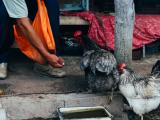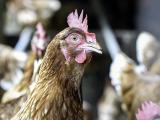Sep 5, 2006 (CIDRAP News) – Mallard ducks in Maryland tested positive for low-pathogenic H5N1 avian influenza, and initial tests pointed to the same findings in Pennsylvania mallards, federal officials said late last week.
Tests ruled out the lethal form of H5N1 virus that has spread through birds in much of Asia and parts of Europe and Africa in the past 3 years, officials said.
In Maryland, researchers from Ohio State University had collected fecal samples from mallards in Queen Anne’s County on the state’s eastern shore in early August, according to a news release from the US Department of Agriculture (USDA) and US Department of the Interior (DOI). Because the mallards showed no signs of sickness, the samples were not rushed and were received by the USDA’s National Veterinary Services Laboratory (NVSL) in Ames, Iowa, Aug 24. On Aug 31, nine samples tested positive for an H5N1 virus. Subsequent genetic analysis suggested that the virus was similar to low-pathogenic strains that have been found previously in North America.
A similar North American strain was confirmed just days earlier in two wild swans in Michigan. Low-pathogenic avian influenza (LPAI) viruses are common in wild birds and typically cause minor illness or no signs of disease. The mild form of H5N1 poses no threat to humans, the USDA said.
In the Pennsylvania situation, the USDA and DOI announced Sep 2 that initial mallard samples taken by state game personnel were positive for the H5 and N1 avian flu subtypes. Testing ruled out the possibility of the highly pathogenic H5N1 strain in the mallards and indicated that the birds likely have the mild strain, the agencies said.
Officials said that two different viruses, one containing H5 (hemagglutinin type 5) and the other containing N1 (neuraminidase type 1), may be present. Tests to clarify whether one or more strains of the virus are present are underway at the NVSL.
The ducks were sampled on Aug 28 in Crawford County, in Pennsylvania’s northwestern corner, by state game personnel in collaboration with the USDA’s expanded wild bird testing program. The birds showed no signs of sickness.
The NVSL will continue testing mallard samples from the two states to determine the pathogenicity of the viruses. Results are expected in about 2 weeks.
Wild birds are known to harbor many influenza viruses, and it's not unusual to find low-pathogenic strains during routine testing, the federal agencies noted.
Mallards are commonly hunted, and though there is no known health risk to hunters or their dogs from contact with LPAI virus strains, the USDA and DOI recommend that hunters use common-sense sanitation and cooking procedures when handling or preparing any kind of wild game.
In other news, the lethal H5N1 strain has surfaced again in poultry in Egypt, 3 months after the last human case was reported, according to a report today from Agence France-Presse (AFP). Egypt’s agriculture ministry confirmed that a new case was found on a poultry farm in Egypt’s southern Sohag province, about 305 miles south of Cairo.
All poultry on the farm were slaughtered, and people who had been in contact with the infected birds were being tested, the report said.
Meanwhile, China is still working on a protocol to share its H5N1 virus samples from poultry with the international scientific community, according to a Reuters report today. Agriculture minister Li Jinxiang told reporters at a news briefing that special procedures are needed when viruses are shipped abroad and that government officials were still working out the details. He said Beijing wanted to conform with World Health Organization (WHO) standards for the transfers.
China has not submitted any avian flu samples since late 2004, the Reuters report said.
A WHO official said China has not yet kept a promise it made last March to provide up to 20 H5N1 virus samples for analysis in WHO-linked laboratories, according to an AFP report published today.
"The logistical arrangements are there to ship those viruses," Julie Hall, a disease expert in the WHO's Beijing office, was quoted as saying. "I don't fully understand why the viruses at this stage haven't been shared."
Hall said the viruses are needed for the development of vaccines and drugs. "China is very important to the jigsaw puzzle," she added. "It has a lot of detailed information."
See also:
Sept 1 USDA and DOI press release on low-pathogenic H5N1 findings in Maryland mallards
Sept 2 USDA and DOI press release on H5 and N1 subtypes in Pennsylvania mallards



















